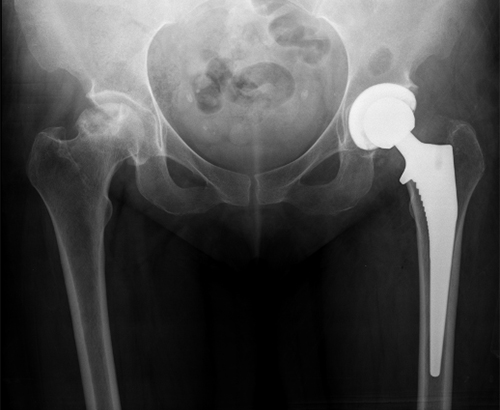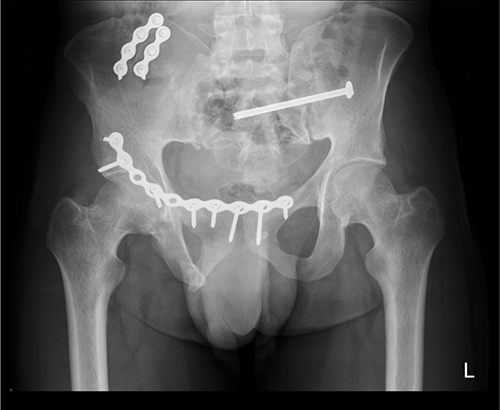Hip Replacement or Hip Arthroplasty
A hip replacement or hip arthroplasty is the gold standard for treatment of a damaged or worn out hip joint. Causes of hip joint degeneration include various types of arthritis, trauma or fracture, avascular necrosis or a sports injury.
Symptoms which you may experience are hip or groin pain, loss of function and/or ability to perform normal daily activities or hobbies/sports and loss of range of motion of the hip.
Conitions Treated: Total Hip Replacement
- Osteoarthritis
- Post traumatic arthritis
- Avascular necrosis of the hip (AVN)
- Rheumatoid arthritis
- Developmental dysplasia of the hip (DDH)
- Congenital/developmental deformities
- Fractures of the hip and/or pelvis
- Previous infection of the hip
- Septic Arthritis (Infection of the hip joint)
- Osteomyelitis (Infection of bone)

X-ray After Hip Replacement
Hip Replacement X-Ray
The x-ray demonstrates severe degenerative hip disease causing the patient significant pain, disability and loss of quality of life.
A left total hip arthroplasty (replacement) was done by Dr Manjra via a minimally invasive, muscle sparing Direct Anterior Hip Approach, relieving the patient of the pain and improving mobility and independence.
The left hip replacement is an example of what we call an “uncemented hip”. In this type of hip replacement, the implant bonds directly to bone without the need for a layer of bone cement between the implant and bone.
Complete Guide To Hip Replacement Surgery
Whether you’re considering surgery or simply want to understand the process, this guide offers valuable insights to help you make informed decisions and achieve the best possible outcome.
Anterior Hip Replacement
The Direct Anterior Approach, or the DAA as it is commonly referred to, is a surgical approach to the hip joint in which the surgeon is able to access the hip joint without the need to cut any of the muscles that support the hip. The hip joint is accessed by working between the muscles.
Therefore it is regarded as a “minimally invasive” or “muscle sparing” approach. Multiple studies have shown that patients experience significantly less pain, use less pain medication after surgery and recover much quicker in the first 6 weeks after hip surgery with the DAA. Patients are also at less risk of certain complications such as a dislocation, where the ball of the prosthesis dislocates out of the cup.
Partial Hip Arthroplasty
(Hemiarthroplasty): In this procedure, only the femoral head is replaced, and the acetabulum is left intact. This is typically indicated for fractures of the femoral head in older patients or for conditions where the acetabulum is not affected by disease.

Pelvis or Hip Trauma Caused Through Injury
The above x-ray demonstrates complex pelvic and acetabular fracture’s due to a high energy motor vehicle accident. Dr Manjra fixed these injuries utilizing a variety of surgical approaches and devices to position the bone fragments in the optimal position for healing. This allows the patient the best chance of returning to pain free motion and activity.
